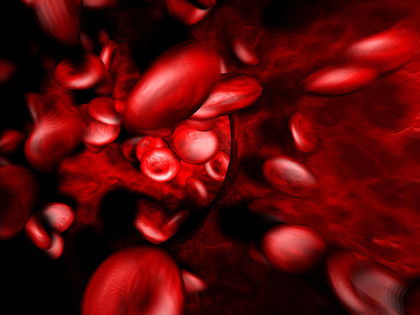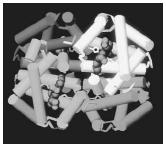Transport Protein


There are two different types of transport proteins: those that carry molecules to "distant" locations (within a cell or an organism), and those that serve as gateways, carrying molecules across otherwise impermeable membranes.
In order for vast numbers of multicellular organisms to exist, they must have a system for delivering oxygen to all their cells, especially those cells that are not in direct contact with the organism's external environment. Hemoglobin is an example of an oxygen-transport protein and is a part of these oxygen delivery systems.
A single human hemoglobin molecule consists of four polypeptide chains. Each of these chains contains a tightly bound prosthetic group called heme. A prosthetic group is a small organic molecule (non-amino acid) that is bound tightly to a protein. At the heart of each heme group is a tightly bound iron atom, to which oxygen binds. The function of hemoglobin is to bind oxygen in the oxygen-rich environment of the lungs, then to release that oxygen to oxygen-poor tissues elsewhere. The polypeptide chains are wrapped around the heme groups in such a way that the affinity between the iron and oxygen is strong enough for hemoglobin to bind oxygen in the lungs, but the resulting bond is weak enough such that hemoglobin will release the oxygen when it encounters organs or tissues that need oxygen. Hemoglobin also performs the complementary function of accepting carbon dioxide from the peripheral tissues and releasing it in the lungs.
Cell membranes are impermeable to charged and polar molecules, meaning that these molecules cannot cross them spontaneously. Some transport proteins are intrinsic to cell membranes and facilitate the transport of polar molecules across the membranes. Each cell of the human body needs glucose , a very polar molecule, and human beings have five different glucose transport proteins (known as GLUT1 through GLUT5) that all serve a similar function: They carry glucose molecules across membranes and into cells. Without these transport proteins, the rate of glucose entry into cells would be very low indeed. Other membrane-linked transport proteins carry other molecules across membranes, including amino acids, ions, and vitamins .
SEE ALSO Proteins .
Paul A. Craig
Bibliography
Berg, Jeremy M.; Tymoczko, John L.; and Stryer, Lubert (2002). Biochemistry, 5th edition. New York: W. H. Freeman.
Horton, H. Robert; Moran, Laurence A.; Ochs, Raymond S.; Rawn, J. David; and Scrimgeour, K. Gray (2002). Principles of Biochemistry, 3rd edition. Upper Saddle River, NJ: Prentice Hall.
Voet, Donald; Voet, Judith G.; and Pratt, Charlotte (1999). Fundamentals of Biochemistry. New York: Wiley.
Comment about this article, ask questions, or add new information about this topic: